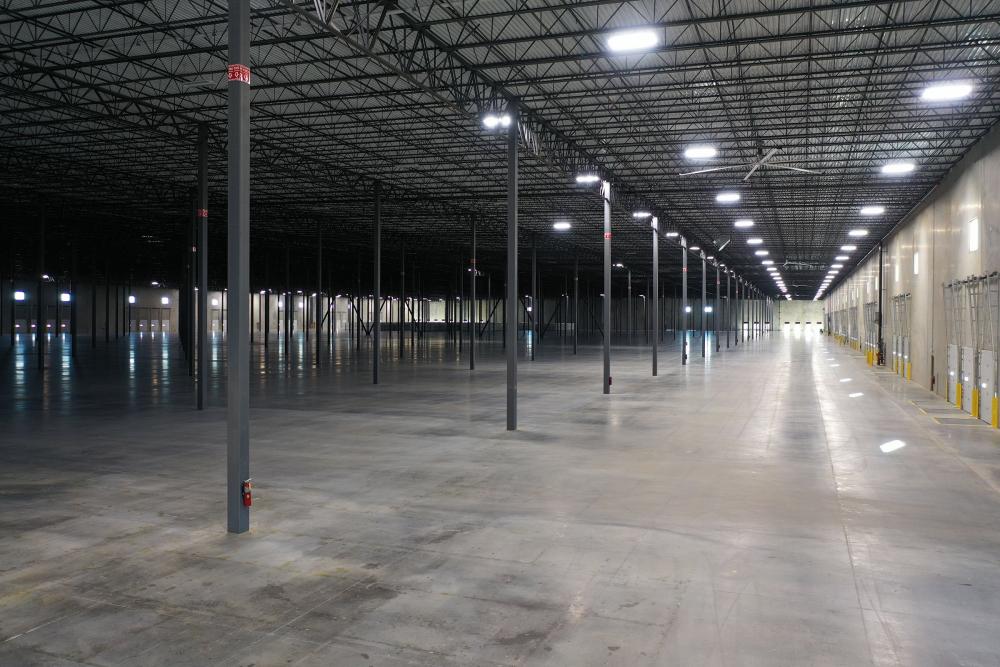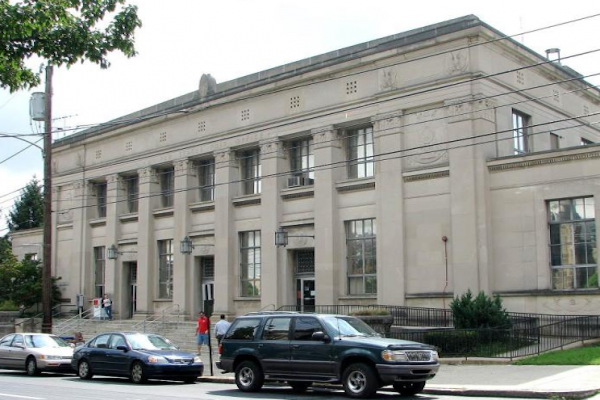This month the Postal Service will begin implementing a massive initiative to change how the mail is delivered. Instead of working out of the back of post offices, letter carriers will be relocated to large, centralized facilities called Sorting & Delivery Centers. These S&DCs will be housed in currently operating processing centers, large post offices, and eventually one of the new multi-functional mega-plants the Postal Service plans to create over the next few years. Spaces are already being prepared in Atlanta, Indianapolis, and Charlotte, where the Postal Service has leased a 620,000 square foot facility almost adjacent to a large Amazon warehouse.
The effects on postal employees will be significant, as discussed in this previous post. Tens of thousands of letter carriers will find themselves working at an S&DC that’s much farther from where they live, meaning longer commutes, more driving time, and more transportation expenses. Postmasters and managers will see their positions downgraded because they don’t have carriers to supervise. Thousands of clerks at post offices will become unnecessary since they won’t need to provide support for the carriers. They will be among the 50,000 positions that the Postmaster General says he plans to eliminate.
Eventually, patrons of post offices will be affected, too. Removing carrier operations eliminates one of the two main functions of a post office, and the excess space in the back will be used to justify “optimizing” the retail network. Some post offices will be relocated to smaller spaces, some will have their hours reduced, many will simply be closed. Properties that the Postal Service owns, many of them significant historic buildings, will be reviewed for disposal. The neighborhoods and towns in which these post offices are located will suffer a loss of jobs and economic activity. Tens of millions of households will fall within the scope of the initiative.
The new delivery network, it’s important to note, is not about closing small, rural post offices — those that typically come under attack because they supposedly don’t bring in enough revenue to justify their existence. The S&DC plan targets urban and suburban post offices.
One of the main criteria — perhaps the main criterion — for identifying which post offices will have their carriers relocated is the distance between the S&DC and the post office. If it’s too far, too much time and expense go into just getting a carrier from the S&DC to the first stop on the route. The Postal Service says a 30-minute drive is the maximum “reach.” Since nearly all the potential S&DCs are in urban and suburban areas, this distance limitation virtually guarantees that the impacted post offices will also be in urban and suburban areas. The post offices in rural areas are just too far afield.
Getting spoked
The Postal Service has provided very few details about the plan. Management is apparently trying to manage the concerns of employees and the public by withholding information. What we do know is that 100,000 carrier routes will be relocated from 6,000 or 7,000 post offices to several hundred S&DCs in current facilities and the 70 new mega-plants. The plan was described in a presentation dated July 29, 2022, and a list dated August 12, 2022, informed employee associations of the first 200 post offices where “conversions” will take place. The Postal Service has said nothing more about which post offices could be impacted.
The July 29th presentation describes the new delivery network in terms of hubs — the sort and delivery centers — and spokes — the post offices that will lose their carriers. One of the questions many people would like to see answered is simply this: Which post offices could become spokes?
With the help of publicly available USPS facility lists, Google maps, and some data crunching, it’s possible to build a model that helps answer this question.
Here’s a map showing 6,100 post offices that could become spoke facilities. If you zoom in, you can see the post offices in clusters around the potential S&DC hubs (in red). The list of spoke post offices is on Google Docs here, where it can be searched, sorted, filtered, and downloaded for further analysis. The list of potential S&DC hubs is here.
Modeling the network
To determine which postal facilities might become S&DCs and which post offices might become spoke facilities, the model used the following inputs.
The July 29th presentation says the Postal Service has identified 928 existing facilities with available space for an S&DC. In an article in Eagle Magazine, the Postal Service says “it will establish a redesigned operational model that will touch almost 500 network mail processing locations.” Based on these comments, the model selected about 770 potential S&DCs.
These include nearly all the 450 Sectional Center Facilities, i.e., processing plants that serve a geographical area defined by one or more three-digit ZIP Code prefixes. It also includes three hundred other facilities: processing plants, large post offices, annexes and network distribution centers. Aside from a few smaller plants, the model includes only those with at least 50,000 square feet. (The July 29th presentation did not include any S&DCs with less than 70,000 square feet.)
Not all these 770 sites are feasible for an S&DC in terms of space, available parking, location, facility type, and other criteria. Some will become unnecessary once the mega-plants are available. Some, like the large post offices, may turn out not to be S&DCs that gain carriers but spoke facilities that lose them. In any case, these 770 sites can serve as proxies for the facilities in the eventual delivery network and help identify which post offices could become spoke offices.
The model includes those post offices that share a 3-digit ZIP prefix with one of the potential S&DCs, and in some cases it includes those with a 3-digit zip that’s nearby. It includes only those that are within a 30-minute drive of the potential S&DC — the maximum one-way reach. In those cases where there was more than one potential S&DC for a particular post office, the model may have chosen a S&DC that was outside the 30-minute reach when then there was another within the reach. The model thus omits several hundred post offices that that would otherwise have been included.
The model does not include the 12,000 Remotely Managed Post Offices — the small rural offices that had their hours cut by POStPlan in 2012. The August 12th list did include a few RMPOs, but they were excluded from the modeling because they are so small they usually have one route or none at all and won’t play a significant role in reaching 100,000 routes. The model also does not include any of the 1,750 Finance Stations and Finance Branches, which by definition don’t have carriers, nor the 2,600 contractor-operated offices, for the same reason.
Using these inputs, the model identified 6,100 offices that could become spoke offices. While the model includes some that are not on the Postal Service’s list and excludes others that are, it provides a framework to analyze the plan as a whole and its potential impacts.
Adding up the impacts
The model shows that the new delivery network is clearly focused on urban and suburban post offices. Using Census data, the model indicates that the 6,100 post offices would encompass ZIP codes in which 116 million people live. That’s a third of the country. Over 105 million of these people live in places classified as “urban.” Sixty percent of the impacted ZIP code areas have populations that are at least 90 percent urban.
The model doesn’t include census data on race, but minorities account for 43 percent of urban areas compared with 22 percent of rural areas. The model’s list contains links to a website with detailed demographic data on the ZIP code for each of the spoke offices.
The distance from the spoke to the potential S&DCs is one of the key issues with the plan. This previous post explained how the July 29th presentation provided enough data to make projections for the entire plan. It showed that the plan would increase the one-way distance between the S&DCs and spoke offices by an average of 13.6 miles and 20 minutes.
The model shows almost exactly that: 12.7 more miles and 20 more minutes. These increases in distance and time will add 750 million round-trip miles to the 100,000 routes and 20 million more work hours, which will require another 10,000 routes. The July 29th presentation acknowledges that the new network will add 5 to 10 percent more routes. The model suggests it will be more like 10 percent.
Plus, the drive times will often be much more than 20 minutes since the model uses data derived by a bulk import from Google maps. They are best-case scenarios and don’t account for traffic, weather, alternate routes, and so on. If you compare the model’s data with a search on Google maps for a particular route at rush hour, you’ll find that the drive time is typically several minutes longer. On average, every extra minute added to the average drive time for the 100,000 routes means another 500 routes.
As discussed in the previous post, the total cost for labor and transportation (fuel, maintenance, etc.) will be about $2 billion. And that’s not even including all the additional time and expense for the carriers going to and from their new workplace at the S&DC. On average, just commuting will mean 120 unpaid hours of work and 5,000 more miles annually.
The plan will also create a massive amount of excess space in post offices. A 2012 OIG report on relocating carriers indicated that delivery units provide about 366 square feet per carrier. The July 29th presentation showed that the new plant in Indianapolis will provide 250,000 square feet for 566 routes, about 440 feet per route. Even using the more conservative OIG estimate, relocating 100,000 routes will involve shifting 37 million square feet of carrier operations from post offices to S&DCs.
About 70 percent of the space needed for 100,000 routes would be located in current facilities, while the rest would be in the new mega-plants, like the one in Northpoint Gateway industrial park in Gastonia, NC, in the metro Charlotte area, where the Postal Service recently signed the lease on a facility with 620,000 square feet — a stone’s throw from a somewhat smaller Amazon facility.

NORTHPOINT GATEWAY 85 (THE BIG ONE IS USPS, THE SMALLER, AMAZON’S)

INTERIOR OF NORTHPOINT GATEWAY 85
The 37 million square feet of excess space that the new network will create in post offices will obviously become a significant issue. The model shows that the 6,100 post offices have about 57 million square feet, so more than half of the total would turn into excess space. In other words, on average, half the floor space of every post office would become excess space. It’s impossible to imagine that the Postal Service will not take steps to address this issue by downsizing the infrastructure.
Optimizing post offices
Google maps has a limit of 2,000 locations per layer, so mapping over 6,000 meant dividing up the list into groups. The map uses the size and type of post office to make four groups: main post offices with less than 3,000 square feet; those with 3,000 to 10,000; and those with more than 10,000. A separate group includes the stations and branches — the city offices that are under the supervision of the city’s main post office and postmaster. The map’s layers can be toggled on and off to see them separately.
The smallest 2,000 post offices, which usually have one to four carrier routes, average about 2,200 square feet for a total of 4.3 million square feet. If half this were to become excess space, it would represent just over two million of the 37 million square feet of excess area the plan will create.
To envision what might happen to the small offices after the carriers leave, it’s useful to look back to 2011-2015, when the Postal Service removed carriers from about 2,700 post offices as part of a Delivery Unit Optimization initiative. These were mostly small offices; on average, 2,300 square feet. More than 90 percent of these DUOed office are still in the same location where they were ten years ago. Apparently, it wasn’t worth the trouble and small cost savings to relocate them to an even smaller space. Over half of these offices, however, had their hours cut and lost their postmasters under POStPlan. Perhaps that’s what will happen to the smaller spoke offices.
Two thousand mid-sized offices average about 6,500 square feet and have about ten carriers. The largest offices, those with 10,000 to 40,000 square feet, average 20,000 square feet. They can have as many as 30 or 40 carriers.
For these mid-size and large post offices, the excess space will become a serious matter. Just cutting hours will not be enough. Postal logic will dictate that something more needs to be done. Relocations to smaller spaces and closures will be inevitable.
The stations and branches are the most vulnerable to closure. The Delivering for America plan says one of its goals is to “evaluate and consolidate low-traffic stations and branches of city Post Offices into nearby full-service retail Post Offices.” This element of the DFA plan will hit big cities the hardest because that’s where stations and branches are concentrated: Philadelphia has 55; Houston, 43; Los Angeles, 40; Brooklyn, 36; Chicago, 34; Manhattan, 31, and so on.
In early 2009, the Postal Service announced it would be reviewing 3,200 of its 4,800 stations and branches for closure under what it called the Stations and Branches Optimization and Consolidation Initiative. (“Optimize,” “consolidate” and “rationalize” are the Postal Service’s preferred terminology for “closed.”) The SBOC hit list kept getting smaller while the PRC went through the process of an Advisory Opinion. At one point the list of probable closures contained 750 post offices, but by the end, the list was down to about 140, and not all of them ever closed.
The Postmaster General will not be satisfied with that outcome for Delivering for America. His 10-year plan calls for $3 to $4 billion in cost savings by “aligning hours of operation to customer demands at low traffic Post Offices” and “rationalizing stations and branches.” Cutting hours might save a few million dollars a year, but the only way to save $400 million a year is by closing post offices. Lots of them.
The “not even modern” postal infrastructure
The Postal Service doesn’t seem to think much of post offices or its properties. At the AEI forum in July, the Postmaster General said the retail network is “so vast that in all the average American only visits a post office two times a year.” His math apparently included every man, woman, and child in the country, and only counted retail transactions, not trips to pick up mail at a PO box or a package that couldn’t be delivered. In contrast, the OIG estimated 2.7 billion visits annually, which comes to over 22 per visits per year per household.
In the current article in Eagle Magazine, the Postal Service also denigrated postal buildings, describing its facilities as “sub-par and often unpleasant working environments” and “not considered state of the art — or even modern — in the logistics world. Most were built many decades ago. It is equally undeniable that this has an effect on performance and on the morale and perceptions of the postal workforce.”
Unfortunately, not all employees will have the opportunity to experience the pleasures of working in one of those new, light-filled, low-stress, modern, state-of-the-art mega-plants. Many will continue working in a “sub-par” P&DC or a large, old post office that’s become a S&DC.
And as for all the “not even modern” postal properties that don’t have a place in the new network? They can and will be sold. Over 2,500 post offices on the model’s list are owned by the Postal Service. It will be impossible to resist bringing in billions of dollars with a fire sale, just as the Postal Service seemed committed to doing ten years ago, when hundreds of historic properties were put on the disposal list. Fortunately, pushback from the Advisory Council on Historic Preservation, the National Trust for Historic Preservation, and several citizens’ groups helped stop the sell-off, but not before dozens were sold and turned into restaurants, offices, and the like, if they were fortunate enough not to be razed.
The Postal Service’s list of 200 offices where the first conversions will occur already contains fifteen historic properties. The model’s list of 6,000 spoke offices contains more than 400. Among them is the post office in Norristown PA which the Postal Service originally put on the market in 2013. Once its 39 carrier routes are gone, it will be back on the closure-and-disposal list again. The same goes for the historic post office in Beacon, NY, one of the five Hudson Valley post offices FDR took a special interest in while he built over a thousand of them. They’re all in danger again.
![]()
BEACON NY POST OFFICE (1937)

NORRISTOWN PA POST OFFICE (1934)
Delivering divestiture
Selling postal property has always been high on the agenda of free-market advocates. It was a major theme of President Reagan’s 1988 Commission on Privatization, which said that “divestiture of federal assets should be pursued” in the interest of ensuring the “highest and best use” of the Postal Service’s assets. The Delivering for America plan will make the sell-off a reality on a massive scale.
Let’s not forget that the same administration that selected our current Postmaster General also produced a Reform Plan calling for the privatization of the Postal Service. The Reform Plan was clear about it: “This proposal would restructure the United States Postal System to return it to a sustainable business model or prepare it for future conversion from a Government agency into a privately-held corporation. Like many European nations, the United States could privatize its postal operator while maintaining strong regulatory oversight to ensure fair competition and reasonable prices for customers.”
Unnecessarily adding hundreds of millions of miles to carrier routes at a cost of $2 billion a year should be cause enough to reject the S&DC plan, but there’s a deeper reason to condemn it. The new delivery network should be seen for what it is: A plan to dismantle the post office infrastructure. Retail postal operations in shopping centers and big box stores are no replacement for the multi-functional, stand-alone, brick-and-mortar post offices that make up this infrastructure. Without them, the postal system becomes just another logistics company. If that happens, full-scale privatization will be just around the corner.
The regulator will monitor
Despite the massive scope of the initiative to transform the delivery network, the Postal Service has not requested an Advisory Opinion from the Postal Regulatory Commission. The Postal Service says the changes will not affect service from the customer’s point of view because the retail operation will remain in place after the carriers leave.
When asked by Ina Steiner at ecommercebytes why the PRC had not initiated a review, the Commission provided a statement explaining that “federal courts and the Commission have previously found that broad strategic plans alone do not trigger this legal requirement [for an Advisory Opinion], although Commission leadership monitors such plans.”
Last year the Attorneys General of twenty states submitted a Complaint to the Commission arguing that the entire Delivering for America plan should be reviewed under the Advisory Opinion statute as soon as possible. The Postal Service’s approach of waiting until implementation is imminent, they argued, means that “the Commission will have to wait a decade” to issue an advisory opinion, at which point “it will be too late” for appropriate Commission review and public participation.
The Commissioners rejected the Complaint for various reasons, among them their view that “articulating broad and high-level future initiatives in a strategic plan cannot be considered instituting or implementing a change with a meaningful impact on service within the meaning of 39 U.S.C. § 3661(b).” In last week’s response to ecommercebytes, the Commission also stated that “local pilot programs are an important step towards implementation but may not meet the nationwide or substantially nationwide standard until they are scaled up more broadly.”
It should be clear that the changes to the delivery network now underway are not simply a “broad strategic plan” or “pilot program.” Implementation has already begun with the acquisition of huge spaces in three cities, notification of the employee unions and associations, and a list of the first 200 post offices that will be converted over the coming weeks and months. The scope of the plan is far reaching and nationwide. You don’t need to wait for it to be “scaled up” to see what’s happening.
Perhaps the Commission will encourage the Postal Service to request an Advisory Opinion on the new delivery network. Or perhaps not. Perhaps there will be no review by the regulator until the Postal Service decides it’s time to announce cuts to retail hours and post office closures. But if the carrier relocations have already occurred, it will be too late to do anything about them. The excess space in post offices will be irreversible, and it will make more dismantling of the postal infrastructure inevitable. The horse will have left the barn. The carriers will have left the building.


Spread the word